This step by step woodworking project is about how to build a 12×16 lean to pavilion – free diy plans. I had been working on this pavilion design for a long time making a lot of fine tuning till I’ve got this perfect shape and structure. The pavilion features a sturdy 6×6 structure with a lean to roof. The whole structure of the pavilion is interesting, so if you want an unique construction in your garden, these are the plans to go to. You will spend hours just watching the intricate structure of the roof unveiling its beauty upon the garden.
We recommend you to invest in the best materials you could afford. Therefore, you should buy weather-resistant lumber, such as pressure-treated lumber, cedar or redwood. If you use regular pine, I recommend you to apply the appropriate products to enhance its durability. Always take accurate measurements before adjusting the size of the components at the proper size. Drill pilot holes trough the components before inserting the wood screws, to prevent the wood from splitting. Please read the Local Building Codes so you determine the right depth of the footings and the pitch for the roof. In addition, they will provide useful information on the joints and other structural / technical aspects. See all my Premium Plans HERE.
Made from this plan

12×16 Outdoor Pavilion – Free DIY Plans
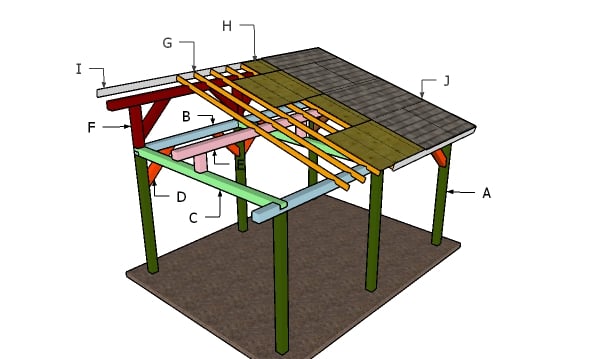
Building a lean to pavilion
Materials
- A – 6 pieces of 6×6 lumber – 96″ long POSTS
- B – 1 piece of 6×6 lumber – 192″ long, 1 piece – 224″ long TOP PLATES
- C – 3 pieces of 6×6 lumber – 144″ long CROSS PLATES
- D – 12 pieces of 6×6 lumber – 36″ long BRACES
- E – 3 pieces of 6×6 lumber – 12 1/2″ long, 1 piece – 224″ long RIDGE BEAM
- F – 3 pieces of 6×6 lumber – 30 1/2″ long, 1 piece – 224″ long, 4 pieces – 36″ long RIDGE BEAM
- 7 pieces of 6×6 lumber – 8 ft
- 7 pieces of 6×6 lumber – 12 ft
- 3 pieces of 6×6 lumber – 20 ft
- 1 piece of 6×6 lumber – 16 ft
- concrete form tube
- 6 post anchors
- 24 pieces of 8″ screws
- 30 pieces of 5″ screws
- wood glue, stain/paint
- 7 pieces of L strong tie
- 6 pieces of post to beam connector
- Screws for Strong ties
- wood glue, stain/paint
Tools
- Safety gloves, glasses
- Miter saw, jigsaw
- Chalk line, tape measure, spirit level, carpentry pencil
- Drill machinery and drill bits
Tips
- Add trims to the pavilion
- Secure the roofing slats to the structure with galvanized screws
Time
- One Week
How to build a 12×12 pavilion
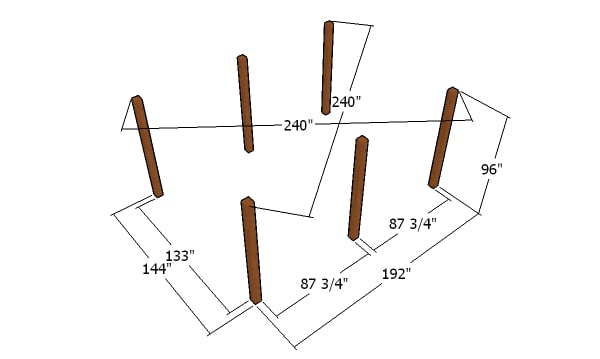
Layout the posts for the pavilion
The first step of the project is to layout the rectangular pavilion. Therefore, select the location for the pavilion and level the surface with attention. Make sure you remove the vegetation layer and even out the surface. Use batter boards and string to layout the location of the legs. Apply the 3-4-5 rule to each corners, so you make sure they are square. Measure the diagonals and make adjustments so they are equal. The local codes will also highlight some guidelines, so you can place the pavilion at the right distance from the fence and other building on the property.

Setting the posts
After marking the location of the posts, you need to dig 3-4′ deep holes in the ground, using a post hole digger. Install tube forms and fit the posts into place, making sure they are perfectly plumb. Secure the 6×6 posts with braces before filling the forms with concrete. For this project we will use post anchors, so you don’t need to set the posts into concrete.
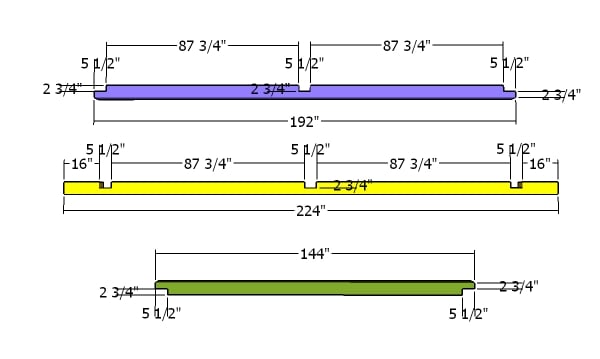
Top plates for pavilion
Use 6×6 lumber for the top plates. Make notches to the beams, using a circular saw. Make parallel cuts and then remove the excess with a hammer and a chisel. Smooth the recesses with sandpaper. These cut outs will help you create half lap joints, which makes for a strong and durable way of bonding wood together.
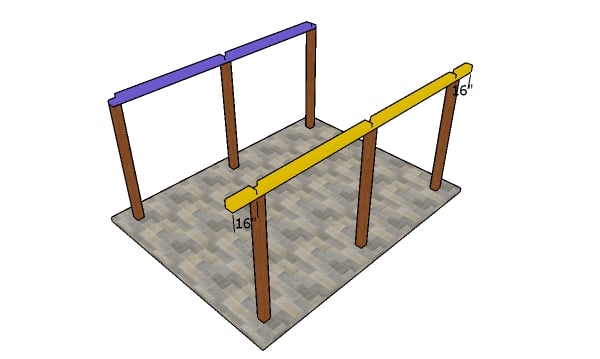
Side plates for pavilion
Fit the plates to the sides of the pavilion. Center the plates to the posts, making sure you have 16″ overhangs on both sides. Drill pilot holes and insert 8″ screws to lock them into place. Plumb the posts with a spirit level and check if the top plate is perfectly horizontal. Make sure the corners are square.
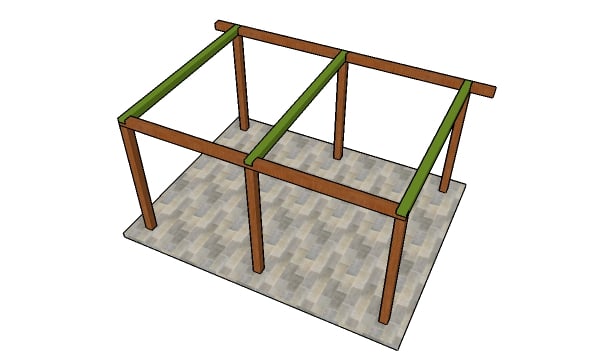
Fitting the cross beams – 12×16 outdoor pavilion
Fit the rest of the plates to the top of the pavilion. Drill pilot holes and insert 8″ screws, to assemble everything together tightly. Make sure the corners are square.
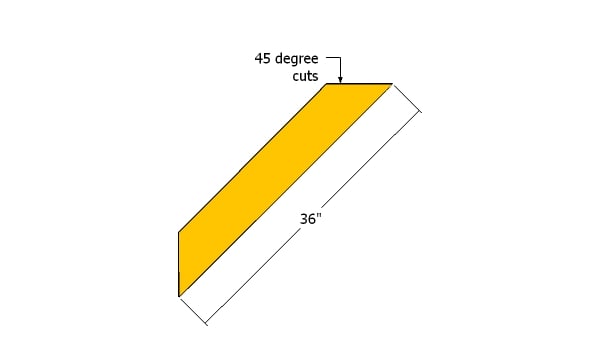
Braces
Use 6×6 lumber for the braces. Make 45 degree cuts to both ends of the braces.
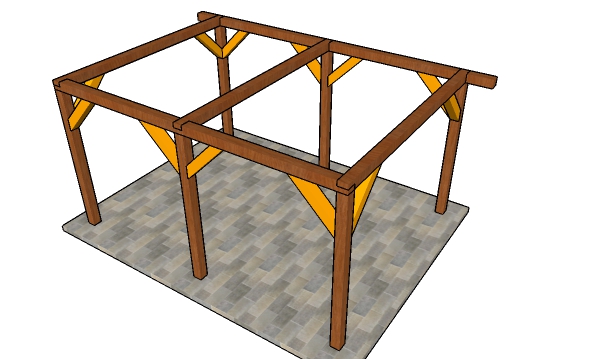
Braces for 12×16 wood pavilion
Lock the braces into place tightly with 5″ screws. Plumb the posts and check if the plates are perfectly horizontal. Drill pilot holes before inserting the screws to prevent the wood from splitting.
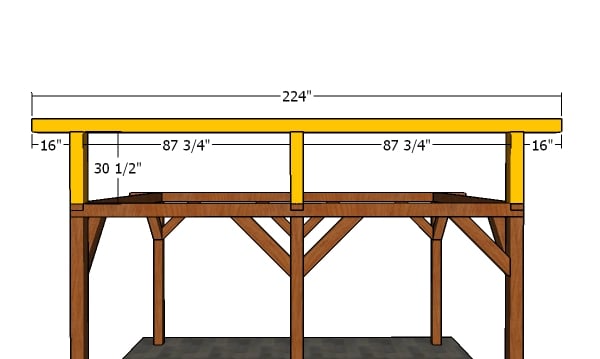
Back ridge beam – 12×16 pavilion
Use 6×6 lumber for the ridge beam and for the supports. Center the supports to the top of the plates and lock them into place with strong tie connectors (L and T for the exterior). Fit the ridge beam to the top of the posts with post to beam connectors.
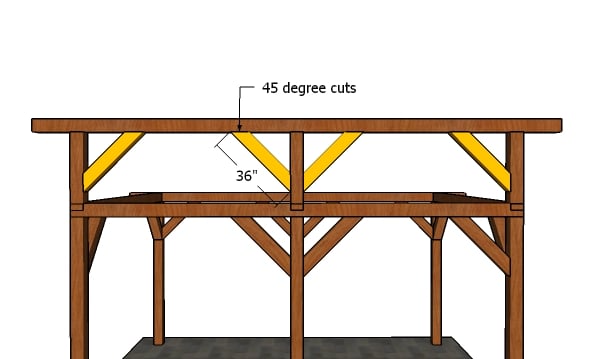
Diagonal braces – ridge beam
Cut the braces from 6×6 lumber, making 45 degree cuts at both ends. Drill pilot holes and insert 5″ screws to lock the braces into place tightly.
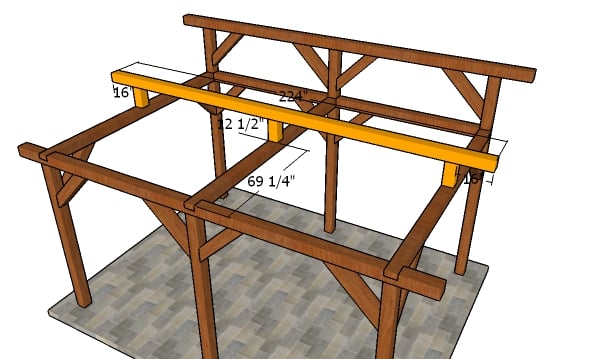
Fitting the middle ridge beam
Fit the middle ridge beam to the top of the plates. Use post to beam connectors to secure the posts into place, as well as to fit the ridge beam.

12×16 Lean to pavilion plans
This pavilion is built on a sturdy 6×6 structure and it features a roof with a 5:12 pitch. You can adjust the slope of the roof to suit your needs.

12×16 Lean to pavilion – free diy plans
This pavilion makes for the perfect addition to a small backyard because it will save you space, since you can place it near the property line or to an already existing building. In addition, the pavilion is sturdy and it last for many decades. Last but not least, you can build this pavilion in a week with the help of another person, and thus, save tons of money as compared to buying one. If you want to build a pavilion with railings, I’ve got you covered with step by step plans.

How to build a 12×16 pavilion
You need to take care of the finishing touches. Therefore, fill the holes with wood putty and then smooth the surface with sandpaper. Apply a few coats of paint or stain over the components to enhance the look of the shed and to protect the components from decay. Please take a look over PART 2 of the project, where I show you how to build the roof for the pavilion.
If you want to download the plans. just click on the GET PDF PLANS button bellow.
Thank you for reading my project about 12×16 backyard pavilion plans and we recommend you to check out the rest of the projects. Don’t forget to LIKE and SHARE our projects with your friends, by using the social media widgets. SUBSCRIBE to be the first that gets our latest projects.


5 comments
It is an awesome plan
Thank you
do you ever help adjust for size? My patio cement is only deep enough for a 10′ deep and my husband isn’t keen on us trying this without plans lol. Also, did you price out how much this one costs to build (using decent cedar 6x6s for instance)?
Thanks.
The maximum length of 6×6 treated lumber available currently is 12′. This plan requires three 20-foot 6×6 and one 16-foot 6×6. How is it possible to build these plans when the required lumber is not available?
Longer sizes are available at Menards for example and other saw mills.